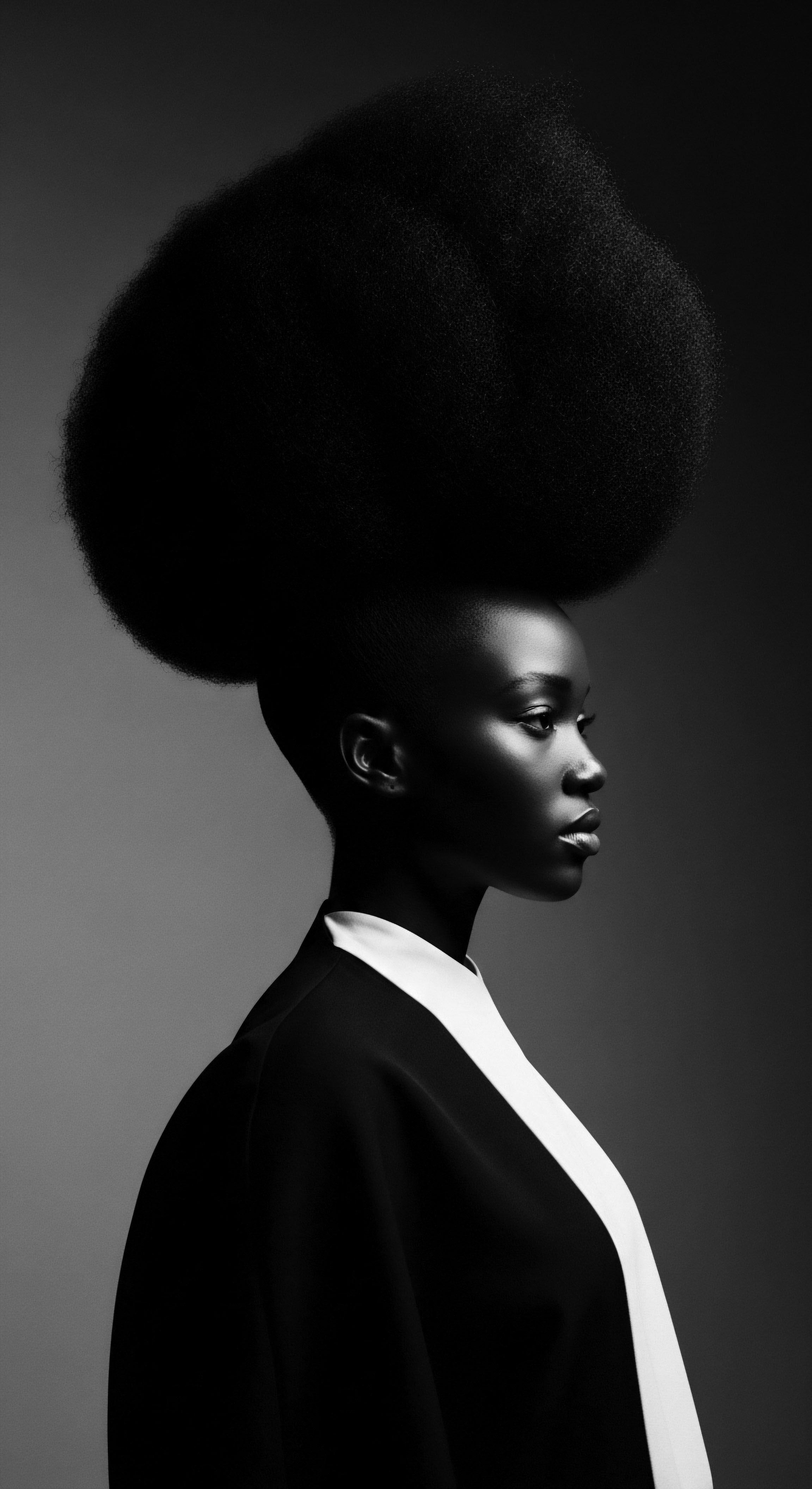
Fundamentals
The concept of Purple Yam Benefits, particularly when considering the ancestral wisdom passed through generations regarding textured hair, speaks to the profound connection between earth’s provisions and our bodies’ vitality. At its heart, the purple yam, scientifically known as Dioscorea alata, is far more than a simple tuber; it is a venerable source of nourishment, a vibrant symbol of resilience, and, as ancient practices whisper, a quiet ally in cultivating hair health. For those new to understanding the subtle interplay of nature and care, purple yam holds a story, one of rich pigments and deep sustenance.
This root vegetable, with its striking violet flesh, offers a compelling array of compounds that contribute to overall well-being. Its nutritional profile, a gift from the soil, includes vital elements such as carbohydrates, potassium, and vitamin C. Tracing its roots, this plant provides an abundance of powerful plant compounds known as antioxidants, notably Anthocyanins.
These give the yam its distinctive color and serve as cellular protectors. Understanding this vibrant hue, therefore, means appreciating its inherent capacity for safeguarding bodily processes, a fundamental aspect of comprehensive care.
Purple yam, or Dioscorea alata, offers a natural wellspring of nutrients and protective compounds that underpin its contribution to vitality and well-being.
Historically, communities relied upon such natural provisions not only for sustaining life but also for maintaining outward manifestations of health, including the hair and skin. The daily sustenance derived from crops like purple yam would have quietly contributed to the structural integrity and growth cycles of hair. The connection rests in the simple truth that a body well-fed, absorbing essential nutrients, is better equipped to support robust hair strands and a thriving scalp. This elemental understanding of internal health reflecting external vibrancy forms a cornerstone of ancestral beauty wisdom, a principle that transcends epochs.
Consider its journey from its origins in Southeast Asia, where it first graced the earth’s bounty. Over centuries, Dioscorea alata travelled across continents, its cultivation spreading through human migration and exchange. This global dissemination speaks to its adaptability and the recognition of its sustained nutritional value by diverse cultures. Its presence became especially notable in regions of Africa, where it became a foundational food source, interwoven into the daily rhythms of life and, by extension, into the traditional practices of self-care.
- Anthocyanins ❉ These are the plant pigments responsible for the purple yam’s deep coloration, acting as powerful antioxidants within the body, guarding against cellular wear.
- Polysaccharides ❉ Long chains of sugar molecules, polysaccharides are vital for moisture retention and creating a protective film, contributing to both skin and hair hydration.
- Vitamins and Minerals ❉ Purple yam delivers vitamin C, which aids in collagen synthesis and iron absorption, and vitamin A, crucial for sebum production, ensuring scalp and hair moisture.
These basic components of purple yam, when understood through the lens of nourishing the body from within, offer a foundational perception of its benefits. For our hair, this means a subtle but steady supply of the building blocks and protective agents needed to maintain strength and resilience. The earliest practitioners of textured hair care, through intuition and observation, understood that robust internal health translated directly into lustrous, pliable hair, a living testament to ancestral care practices.

Intermediate
Expanding upon the foundational understanding, the intermediate interpretation of Purple Yam Benefits delves deeper into the specific compounds at play and their implications for the unique characteristics of textured hair. This section bridges the elemental wisdom of ancestral usage with more precise insights into how this tuber supports the delicate structures of strands and scalp, honoring a continuous line of knowledge that spans ages. The understanding of its impact extends beyond simple nourishment, reaching into the realm of cellular protection and follicular vitality.
The rich purple hue of Dioscorea alata, often called ube or violet yam, signals the abundant presence of Anthocyanins. These potent antioxidants are not merely colorants; they are diligent guardians against oxidative stress, a process that can harm hair follicles and contribute to issues such as premature graying and hair loss. By neutralizing damaging free radicals, anthocyanins work to preserve the integrity of each hair follicle, ensuring it remains a sturdy anchor for growth. This protective quality is particularly pertinent for textured hair, which, owing to its structural design, can be more susceptible to environmental stressors and mechanical manipulation.
Beyond their antioxidant capabilities, certain components within purple yam, such as Polyphenols, exhibit anti-inflammatory properties. Scalp inflammation, a silent disruptor, can impede the natural hair growth cycle. The presence of polyphenols helps create a more hospitable environment for hair growth by soothing irritation at the follicular level. Imagine the relief provided by ancestral tonics, often concocted from earth’s provisions, gently calming a distressed scalp—a wisdom now echoed in modern scientific observations regarding anti-inflammatory agents.
| Aspect of Hair Care Scalp Nourishment |
| Ancestral Understanding (Historical Practice) Consumed as a dietary staple for overall health, observed to support vital bodily functions. |
| Contemporary Scientific Explanation Provides vitamins A and C, and iron, assisting sebum production and oxygen delivery to follicles. |
| Aspect of Hair Care Hair Strength & Resilience |
| Ancestral Understanding (Historical Practice) Believed to fortify the body, leading to healthier physical manifestations. |
| Contemporary Scientific Explanation Anthocyanins and polyphenols protect follicles from oxidative damage and inflammation. Diosgenin may stimulate dormant follicles. |
| Aspect of Hair Care Moisture Retention |
| Ancestral Understanding (Historical Practice) Associated with succulent, hydrating foods that contribute to internal moisture. |
| Contemporary Scientific Explanation Polysaccharides form a film on hair, aiding in sustained hydration and frizz reduction. |
| Aspect of Hair Care The age-old reliance on nature's bounty, like purple yam, consistently finds contemporary validation for its contribution to hair vitality. |
Another compelling compound found in yams, including some purple varieties, is Diosgenin. Though research specifically on purple yam’s diosgenin content for hair is still developing, studies on other sources of diosgenin indicate its potential role in stimulating dormant hair follicles and encouraging growth. This suggests a deeper, more direct interaction with the very mechanisms of hair regeneration. Ancestral concoctions, often utilizing various parts of plants, might have inadvertently capitalized on such bioactive compounds, relying on generations of observation and empirical knowledge.
The molecular composition of purple yam, rich in protective anthocyanins and soothing polyphenols, offers a sophisticated account of its benefits for textured hair.
The presence of water-soluble Polysaccharides in purple yam further elevates its standing in hair care. These long-chain carbohydrates possess remarkable film-forming abilities, adhering to hair strands and providing lasting moisturization. For textured hair, which often possesses a more open cuticle layer, prone to moisture loss, this attribute is invaluable.
Imagine the historical practices of applying natural mucilaginous substances to coils and curls to keep them supple and protected; these ancient techniques often align with the contemporary understanding of polysaccharide function. Such properties not only hydrate but also improve wet and dry combability and assist in reducing frizz, creating smoother, more manageable hair.
The wisdom of those who came before us recognized that what sustained the body internally also supported its external expressions of vigor. The regular incorporation of nutrient-dense foods like purple yam into traditional diets would have provided a steady stream of the very building blocks needed for healthy hair. This dietary approach, prioritizing whole, unprocessed foods, underscores a holistic philosophy where hair care is an extension of overall wellness. It was not merely about topical applications but about nurturing the entire being.

Academic
The academic understanding of Purple Yam Benefits, particularly as it intersects with the heritage of textured hair care, reveals a complex interweaving of ethnobotanical wisdom, molecular biology, and cultural resilience. This definition transcends superficial observations, delving into the specific biochemical contributions of Dioscorea alata and its historical adoption within Black and mixed-race communities, a testament to deep ancestral knowledge. The insights gained from rigorous inquiry affirm the long-held intuitions of past generations, offering a robust framework for contemporary appreciation.
Central to the definition of purple yam’s merits are its primary bioactive compounds ❉ the spectrum of Anthocyanins, the versatile Polyphenols, and the intriguing steroid saponin, Diosgenin, alongside various polysaccharides . Anthocyanins, such as cyanidin and peonidin derivatives, are responsible for the tuber’s intense coloration and its substantial antioxidant capacity. Oxidative stress, arising from environmental aggressors and metabolic processes, significantly contributes to hair follicle damage, leading to weakened strands and compromised growth cycles.
Research indicates that the high antioxidant activity of purple yam extracts directly counters these deleterious effects, safeguarding cellular integrity within the scalp and follicle. This protective action is especially relevant for highly coiled or kinky hair textures, which can experience increased exposure and susceptibility to damage due to their structural formation and the manipulations often required for daily maintenance.
The profound value of purple yam for textured hair resides in its powerful antioxidants and restorative compounds, which align with ancestral wisdom concerning deep nourishment.
Beyond oxidative defense, purple yam’s polyphenols exhibit anti-inflammatory properties, a critical attribute for scalp health. Chronic inflammation, a common precursor to various scalp conditions and hair thinning, can disrupt the anagen (growth) phase of the hair cycle. The presence of these anti-inflammatory agents helps to establish a quiescent microenvironment around the hair bulb, thus promoting healthier, uninterrupted hair growth. This scientific validation echoes the calming and healing intentions of traditional hair care practices, which often involved applying natural poultices or infusions to soothe irritated scalps, recognizing the direct link between a healthy foundation and vibrant hair.
The role of Diosgenin, a phytosteroid present in yams, warrants particular academic attention. While Dioscorea alata is known for its diosgenin content, broader research on various yam species reveals its potential to stimulate hair follicles. Studies exploring herbal hair oil formulations containing diosgenin have indicated its capacity to aid the scalp’s efficient absorption of nutrients and stimulate dormant hair follicles, presenting it as a promising compound for promoting hair growth and even reducing premature graying. (Bhargavi, Makwana, & Pandya, 2024, p.
5851). This finding brings a fascinating dimension to the ancestral use of yams as a medicinal plant for various ailments, suggesting an implicit understanding of its restorative capabilities extending to hair vitality. The mechanism may involve its influence on specific signaling pathways or direct interactions with follicular cells, prompting a more vigorous growth phase.
The polysaccharides within purple yam also contribute significantly to its benefits, particularly for hydration and structural integrity. These complex carbohydrates possess a remarkable affinity for water, making them effective humectants. Upon application, they form a delicate, invisible film on the hair shaft, effectively sealing in moisture and mitigating dehydration. This property is exceptionally beneficial for textured hair, which inherently tends to experience greater moisture loss due to its raised cuticle structure.
The film-forming attribute also aids in smoothing the hair cuticle, reducing friction, and improving both wet and dry combability, thereby minimizing breakage during detangling—a challenge well-understood within textured hair care traditions. The ability of polysaccharides to contribute to anti-frizz effects further enhances hair manageability and appearance.
A powerful historical example that illuminates the profound connection between purple yam benefits and textured hair heritage can be seen in the botanical legacies of the African diaspora. While African staple yams (like Dioscorea cayenensis and D. rotundata ) were foundational, the Asian yam ( Dioscorea alata, purple yam) was also adopted in prehistory and became a significant part of food purchases during the transatlantic slave trade. As Carney and Voeks (2003) describe, European slavers provisioned their ships with various Old World plants, and enslaved Africans, through their resourcefulness and deep botanical knowledge, cultivated these new species in their subsistence plots and gardens.
The mere survival of enslaved Africans, often under unimaginably harsh conditions, was inextricably linked to their ability to adapt and utilize available food sources. Given the nutritional richness of Dioscorea alata, including its vitamins, minerals, and antioxidants, its consistent consumption would have indirectly supported overall physiological health, which directly translates to the health of hair, skin, and nails. The ingenuity and persistent knowledge of these communities, who even incorporated newly introduced plants into their daily sustenance, illustrate a proactive stance towards well-being that transcended mere caloric intake. This adaptive ethnobotanical practice, born of necessity and maintained through generational transmission, positioned plants like the purple yam not just as food, but as components of a broader system of health, including the vibrancy of hair, which was, and remains, a potent symbol of identity and resistance.
This historical precedent reveals a deeper interpretation of “benefits” ❉ not just isolated biochemical effects, but the holistic sustenance that allowed a community to endure and retain aspects of their cultural identity, where hair care was an integral part of self-presentation and communal bonding. The very act of consuming and utilizing such nutrient-dense plants becomes an ancestral practice of nourishing the body from the inside out, providing the foundational strength from which healthy hair emerges.
The interplay of these compounds—anthocyanins for their antioxidant prowess, polyphenols for their anti-inflammatory action, diosgenin for its potential follicular stimulation, and polysaccharides for their hydrating and protective film-forming qualities—collectively define the complex benefits of purple yam. The scientific community continues to explore the full spectrum of Dioscorea alata ‘s effects, particularly in dermatological and cosmetic applications. For example, research suggests that the antioxidant properties of sweet potato extracts, including those with purple flesh, stimulate collagen synthesis and offer protection against photoaging, underscoring broader skin health benefits that often mirror those seen in hair.
A systematic approach to understanding these benefits involves considering the plant’s constituents in concert rather than in isolation.
- Antioxidant Defense ❉ Purple yam’s array of anthocyanins and vitamin C actively scavenge free radicals, shielding hair follicles from oxidative damage that can lead to thinning and premature graying. This cellular protection is a fundamental aspect of maintaining youthful, robust hair.
- Anti-Inflammatory Action ❉ Polyphenols within the yam work to reduce inflammation on the scalp, establishing a calm, conducive environment for consistent hair growth and minimizing discomfort. This speaks to the wisdom of nurturing the scalp as the very ground from which hair springs.
- Follicular Stimulation ❉ The presence of diosgenin hints at a potential to awaken dormant hair follicles and enhance nutrient absorption at the root, promising a more vigorous hair growth cycle. This mechanism holds particular promise for addressing hair density.
- Moisture and Structure ❉ Water-soluble polysaccharides create a hydrating veil over hair strands, improving moisture retention, reducing frizz, and enhancing overall manageability, a significant consideration for preserving the integrity of diverse curl patterns.
The academic lens thus confirms what centuries of practical experience whispered ❉ that nature holds potent solutions for well-being, and that the purple yam, a dietary cornerstone for many ancestral communities, is a significant contributor to the enduring vibrancy of textured hair. Its multifaceted chemical composition, when examined through the rigorous methodology of modern science, validates the inherent efficacy of traditional uses, deepening our respect for the botanical heritage upon which so much hair care wisdom rests.

Reflection on the Heritage of Purple Yam Benefits
Considering the multifaceted attributes of purple yam, its significance extends far beyond its scientific composition; it reaches into the very spirit of how Black and mixed-race communities have honored their textured hair throughout history. The journey of Dioscorea alata from distant shores to becoming a dietary cornerstone, and by extension, a quiet participant in ancestral beauty rituals, speaks to an enduring ingenuity. This tuber embodies a living archive, a narrative of resilience woven into the very fabric of identity. The wisdom of those who came before us recognized that nourishment from the earth fortified not only the body but also the spirit, reflecting in the strength and luster of our strands.
The very concept of hair as a profound marker of heritage, a conduit for stories and traditions, gives the purple yam’s benefits an added layer of meaning. It reminds us that every act of self-care, every ingredient chosen, can be a conscious connection to a legacy of knowledge and adaptation. The gentle hum of ancestral practices, from the diligent preparation of healthful foods to the mindful application of natural remedies, finds a contemporary echo in our renewed appreciation for ingredients like purple yam. Our textured hair, a living testament to journeys and transformations, continues to receive sustenance from the earth’s timeless gifts.

References
- Bhargavi, N. M. Himanshu, T. & Pandya, D. J. (2024). Estimation of Ursolic acid and Diosgenin in Herbal hair oil formulations used for Hair loss and Grey hair activity by using RP-HPLC Method. Research Journal of Pharmacy and Technology, 17 (12), 5851-5854.
- Carney, J. (2013). Seeds of Memory ❉ Botanical Legacies of the African Diaspora. Penn State University Press.
- Carney, J. & Voeks, R. A. (2003). African traditional plant knowledge in the circum-Caribbean region. Journal of Ethnobiology, 23 (2), 167-184.
- Moriya, T. et al. (2015). New acylated anthocyanins from purple yam and their antioxidant activity. Bioscience, Biotechnology, and Biochemistry, 79 (9), 1484-1492.
- Krochmal-Marczak, B. et al. (2021). Sweet potato root extract cream on wrinkle reduction, skin moisture, and elasticity. ResearchGate.
